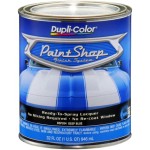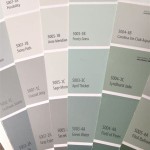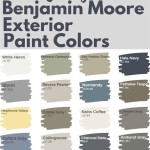What Colours To Paint A Fence
Selecting a fence colour transcends mere aesthetics. It’s a decision that impacts curb appeal, garden harmony, neighbourhood cohesiveness, and even the longevity of the fence itself. The chosen colour can make a garden appear larger, complement existing architecture, or provide a contrasting backdrop for landscaping. Considerations must extend beyond personal preference to encompass the surrounding environment and the practical implications of pigment choice.
The material of the fence is a primary determinant in colour selection. Wooden fences, for instance, are porous, allowing for deeper colour penetration and a wider range of aesthetically pleasing options, from natural stains that accentuate the wood grain to solid paints that offer complete coverage. Metal fences, on the other hand, often require specific primers and paints designed to adhere to their surfaces and prevent rust. Vinyl fences typically do not require painting, but if a change is desired, specialized paints formulated for plastic are necessary to ensure proper adhesion and prevent peeling.
Beyond material considerations, local regulations and homeowner association guidelines may significantly restrict colour choices. Some communities enforce strict colour palettes to maintain a uniform appearance, while others may have rules regarding the prominence of certain hues. Before embarking on a painting project, it's essential to consult with local authorities or the relevant homeowner association to avoid potential fines or the need to redo the work.
Understanding the Impact of Colour Psychology
Colour psychology plays a significant role in how we perceive our environment. Different colours evoke distinct emotions and associations, influencing the overall feeling of a garden or outdoor space. For instance, lighter colours, such as white or pale grey, reflect sunlight, making the area feel brighter and more spacious. These colours are often associated with cleanliness, peace, and serenity.
Conversely, darker colours, like deep browns or charcoal grey, absorb sunlight, creating a more intimate and grounded atmosphere. These hues can provide a striking contrast to lighter-coloured plants and flowers, making them stand out. However, darker colours can also make a small space feel smaller and more enclosed.
Green, a colour intrinsically linked to nature, is a versatile choice for fences. It blends seamlessly with foliage, creating a harmonious and natural backdrop for gardens. Different shades of green can evoke different moods, from the vibrancy of lime green to the calmness of forest green.
Blue shades, particularly lighter blues and teals, can create a tranquil and relaxing atmosphere. These colours are often associated with water and sky, lending a sense of openness to the outdoor space. However, using too much blue can sometimes feel cold or impersonal, so it’s often best used as an accent colour or in combination with warmer tones.
Warmer colours like reds, oranges, and yellows can add energy and vibrancy to a fence and the surrounding area. However, using these colours requires careful consideration, as they can be overwhelming if not balanced effectively. They are often best used as accent colours or in smaller doses to create visual interest.
Matching Fence Colour to Architectural Style and Landscaping
The architectural style of the house and the surrounding landscape should heavily influence the choice of fence colour. A modern home with clean lines might benefit from a minimalist colour palette of greys, whites, or blacks. These neutral tones complement the contemporary aesthetic and create a sophisticated look.
Traditional homes, such as those in Victorian or colonial styles, often look best with classic fence colours like white, off-white, or muted greens. These colours evoke a sense of history and elegance, aligning with the architectural character of the house.
For homes with a more rustic or natural aesthetic, earth tones like browns, beiges, and greens are ideal choices. These colours blend seamlessly with the natural environment and create a sense of harmony between the house and its surroundings.
The landscaping also plays a crucial role in determining the best fence colour. Consider the colours of the plants, flowers, and other landscaping elements when making a decision. A fence colour that complements the existing foliage will create a cohesive and visually appealing outdoor space. For example, a dark green fence can provide a striking backdrop for brightly coloured flowers, while a white fence can make a lush green lawn appear even more vibrant.
Consider the overall goal for the garden. Is the aim to create a sense of privacy and seclusion? Darker fence colours tend to recede into the background, making the garden feel more enclosed and intimate. Conversely, lighter fence colours can make a small garden feel more spacious and open.
Practical Considerations: Durability and Maintenance
The durability and maintenance requirements of different fence colours are also essential factors to consider. Darker colours tend to absorb more heat from the sun, which can cause the fence to expand and contract more substantially over time. This can lead to cracking, peeling, and fading, requiring more frequent maintenance.
Lighter colours, on the other hand, reflect sunlight, which can help to keep the fence cooler and reduce the likelihood of heat-related damage. However, lighter colours are more prone to showing dirt, mildew, and other stains, requiring more frequent cleaning.
The type of paint or stain used also affects the durability and maintenance of the fence colour. High-quality paints and stains are designed to withstand the elements and resist fading, cracking, and peeling. It's generally advisable to invest in premium products, even if they come at a higher cost, as they will ultimately save time and money in the long run by reducing the need for frequent repainting.
For wooden fences, consider using a stain that contains UV inhibitors to protect the wood from sun damage and prevent the colour from fading. For metal fences, use a paint that is specifically designed for metal surfaces and contains rust inhibitors to prevent corrosion.
The geographic location and climate also influence the choice of fence colour. In areas with harsh weather conditions, such as extreme heat, cold, or humidity, it's especially important to choose a durable paint or stain that can withstand the elements. In coastal areas, consider using a paint that is resistant to salt spray and corrosion.
The level of maintenance required can also be a deciding factor. For those who prefer a low-maintenance option, consider a fence material that doesn't require painting, such as vinyl or composite. If painting is necessary, consider using a self-priming paint that simplifies the process and reduces the amount of time and effort required.
Ultimately, the best fence colour is a matter of personal preference, but it's important to consider all of these factors before making a decision. By carefully weighing the aesthetic, practical, and environmental considerations, a fence colour can be chosen that enhances the beauty of the property, provides lasting protection, and complements the surrounding environment.
Before committing to a particular colour, it is advisable to test it on a small, inconspicuous area of the fence. This allows for an assessment of how the colour looks in different lighting conditions and how it interacts with the surrounding landscape. It also provides an opportunity to evaluate the application process and the durability of the paint or stain. Small sample pots of paint are often available at hardware stores for this purpose.

Fence Paint Color Ideas To Boost Curb Appeal Wow 1 Day Painting

Best Colour For Fences In Small Gardens

What Is The Best Fence Paint Colour Shed

Do S And Don Ts For Choosing The Right Fence Colour Maria Killam

Best Fence Colours For Small Garden The Paint Guide

Which Fence Paint Is Best Top 5 Paints

Fence Paint Color Ideas To Boost Curb Appeal Wow 1 Day Painting

Tips For Choosing Paint Color Your Fence Pentagon

Do S And Don Ts For Choosing The Right Fence Colour Maria Killam

The Orange Fence Is Gone
Related Posts








